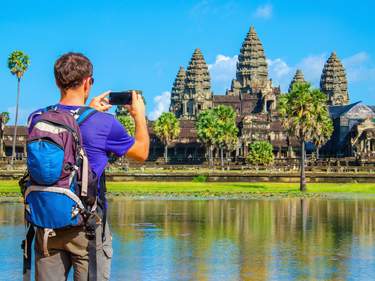Battambang is often overlooked. It lacks the obvious Cambodian trump cards: no golden beaches, no capital city buzz, and no Angkor Wat. But then neither does it suffer from congested traffic, coach loads of tourists, or hordes of touts. In fact, Cambodia's second-largest city is one in perfect balance – it’s bustling yet friendly and interesting without being overwhelming. Underneath its sleepy persona is a bubbling undercurrent of creativity, often fuelled by the expat community. A smattering of arty boutique hotels, quirky cafés and innovative restaurants are among the urban draws, while the lush surrounding countryside is ideal for excursions. Here, we’ve whittled down the top 7 reasons to visit.
For the restaurants
Some of Cambodia's best natural produce coupled with an expat-driven demand for good restaurants make Battambang an exciting place to eat out. The vibe is low key – cheap food stalls, laidback local haunts, arty cafés tucked down quiet sidestreets – with a focus on Khmer, French and Western cuisines.
For classic French favourites, as well as creative dishes blending Khmer and French influences (think sautéed frog with Khmer pesto), try Pomme d'Amor or pop into Lotus, a chic restaurant-bar set in a renovated exposed-brick-walled shophouse. The real buzz, however, is about Jaan Bai. One of Battambang's newest ventures, this innovative restaurant skilfully combines Khmer, Vietnamese and Thai influences in tapas-sized dishes. The seven-course set menu is a steal at $15 per person, and includes dishes such as Kampot pepper crab with chilli jam and a zingy papaya and shrimp salad. The restaurant, which has received the support of Australian chef David Thompson, also doubles up as a social enterprise, training underprivileged young people and giving its profits to the Cambodian Children's Trust.
For free-wheeling
The countryside around Battambang lends itself perfectly to exploration by bicycle. Bumpy roads lead past simple shacks, monasteries that echo with the sounds of chanting and village streets taken over with colourful wedding celebrations. At times the dusty, ochre tracks are only wide enough for a single bike – tricky when you occasionally have to squeeze between a herd of cattle. At other moments paths open out into an expanse of vivid-green rice paddies threaded with lazy streams.
Take one of Soksabike’s half- or full-day tours and your journey will be also punctuated with trips to local families to learn about cottage industries – from rice wine production to weaving – giving a well-earned break from the saddle and a valuable insight into local Khmer life.



















